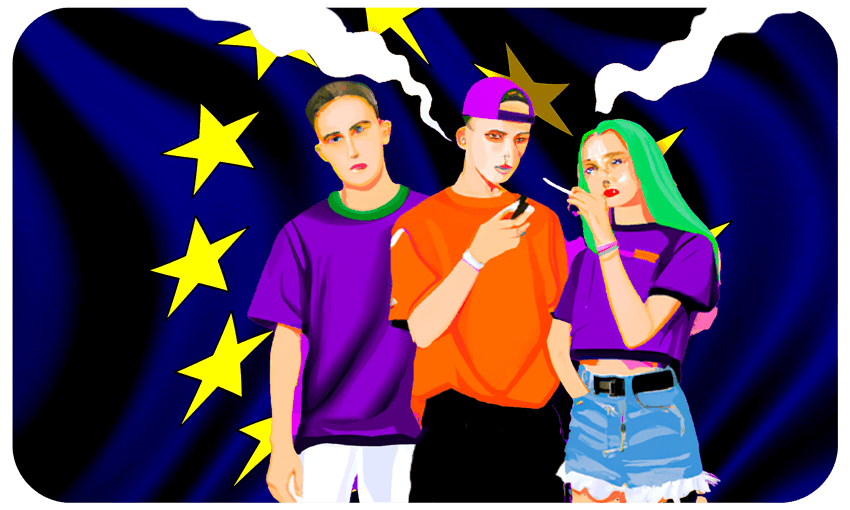In New Zealand I was only a casual smoker – it was far too expensive to be anything else. That all changed when I went on holiday to Europe.
I’m strolling down a street in Vienna. It’s one of the hottest European summers on record. The sun kisses my bare shoulders. Coffee houses and restaurants spill people onto the streets.
Everywhere, young people are sipping icy-cool spritzers and smoking.
On every corner, there’s at least one suave young male leaning against a centuries-old building facade, cigarette in hand. Groups of giggling girls everywhere, sitting on steps, delicate fingers rolling tobacco, smoking.
Another week, another European street.
This time I’m in Corfu. Tipsy, stumbling along the pavement, my amor de mi vida laughing next to me. In my hand is a pack of Marlboro Golds purchased for five euros – the equivalent of NZ$8.
If I was to teleport back to my small-town New Zealand home, the same pack of cigarettes would cost me more than $45.
I am honestly gobsmacked by how cheap it is to smoke in Europe compared to the exorbitant costs back home.
Drinking Aperol spritz in the delightfully hot Greece evening, we smoke almost the entire pack. Every outdoor table at the bar in Old Town is full of young people doing the same, filling the air with smoke and laughter.
I have never seen so many young people smoking.
Growing up in New Zealand, I was taught from day one at primary school just how bad smoking is for you. Public places were branded with forest green Smokefree signs.
My grandfather, an excessive smoker in his youth, had throat cancer. The moral of his story, passed down to me: stay away from cigarettes. It was dangerous habit that would coat my lungs with tar, creating slick black roads of my bronchi and bronchioles.
I grew up in the knowledge that New Zealand aimed to be completely smokefree one day, within my lifetime.
Once I started studying at university, curiosity naturally got the best of me. I wasn’t alone. Escape onto the deck of any nightclub for a breather from the sweaty crowds and heavy bass and you’ll find plenty of young people hitting cigarettes or a vape.
Before this year, though, I had never bought my own pack of cigarettes. I was content with a puff or two from someone nearby with a lit ciggie in hand.
Most people I noticed outside New Zealand nightclubs were vaping. Those who were smoking cigarettes were unlikely to offer you a whole one from their pack, even if you asked nicely.
In New Zealand it’s far, far too expensive to give your cigarettes away.
Fast-forward to the last four months I’ve spent travelling Europe. I ask for a puff and get given a whole cigarette and I’m welcome to ask for more.
I spent time working from home alongside three young British guys who stop for a literal smoko break multiple times in the day. A Swiss friend makes it through multiple packs a day and needs snus (a small powdered tobacco pouch placed behind the upper lip) if he’s not inhaling.
None of my friends back in New Zealand smoke like this.
Twenty-nine percent of the European Union’s population aged 15-29 smoke. In comparison, the current smoking rate for 18-24-year-olds in New Zealand is 11%.
Europe has been attempting to reduce the number of people smoking. France, like New Zealand, has high cigarette taxes, yet the illicit market grows annually, driven by local demand.
Based on New Zealand’s example, stopping young people from smoking depends not just on smokefree policies and tighter regulations but also on societal change and attitudes.
Research indicates if you can make it to 25 years old without tasting a cigarette, you will likely never smoke.
With fewer adults smoking, and cigarette packets hidden behind nondescript cupboards in supermarkets, it’s out of sight, out of mind for many of New Zealand’s youth.
If you do think about buying, the lavish prices often make you stop and wonder if it’s necessary.
On July 27, New Zealand took another step forward in its plan to be smokefree by 2025. The Smokefree Environments and Regulated Products (Smoked Tobacco) Amendment Bill had its first reading in parliament.
If the bill is passed, it will be illegal to sell tobacco to people born in 2009 or later, creating an entire smokefree generation.
In Europe, however, smoking is the norm. I would even suggest, based on my own behaviour here, that it’s romanticised and entwined in European culture. It’s as much a part of daily life as drinking espresso.
The low prices make it even more accessible.
The European Union is aiming for less than 5% of the population using tobacco by 2040, but societal attitudes continue to hinder progress.
New Zealand is winning the war on cigarettes – but the next challenge is vaping.
While the number of those aged 14-15 who smoke daily continues to decline, reaching an all time low of 1.3% last year, the rates of vaping are actually increasing.
If New Zealand wants to reach its smokefree goals, greater attention needs to turn to young people vaping.
Vaping, initially encouraged as a way for smokers to stop smoking, is now becoming a gateway for younger generations to get that head-spin rush.
And it’s my generation who are going to be the guinea pigs of what vaping actually does to us in the long-term.



